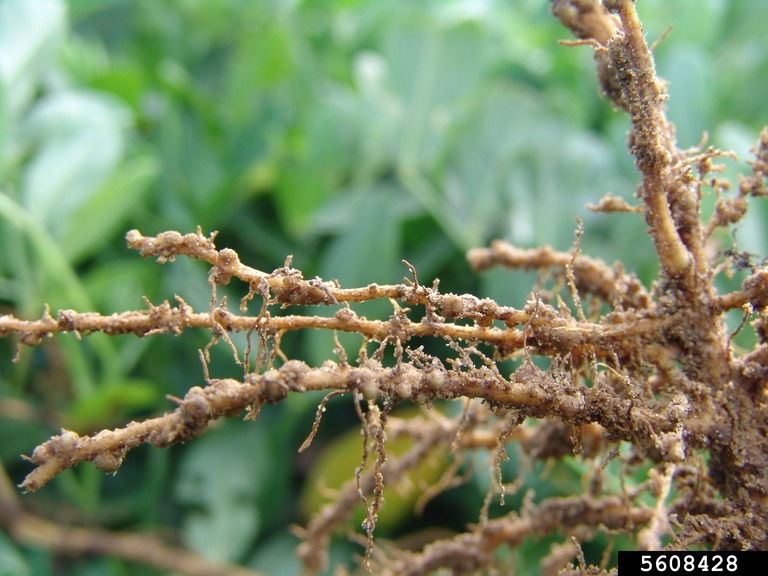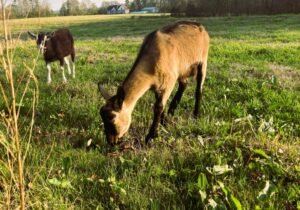
rhizobium bacteria.jpg
Rhizobium Bacteria
Definition
Rhizobium bacteria are a group of soil-dwelling bacteria belonging to the genus Rhizobium, known for their ability to form symbiotic relationships with leguminous plants and fix atmospheric nitrogen. These bacteria play a crucial role in biological nitrogen fixation, supporting plant growth, soil fertility, and sustainable agricultural practices.
Informational Content
Rhizobium bacteria establish symbiotic associations with the roots of leguminous plants, such as peas, beans, clover, and alfalfa, through a process called nodulation. Nodulation occurs when compatible strains of Rhizobium bacteria infect legume roots, inducing the formation of specialized structures called nodules. Within nodules, Rhizobium bacteria convert atmospheric nitrogen into ammonia, a form of nitrogen that can be assimilated by plants for protein synthesis and growth. This symbiotic relationship benefits both the bacteria and the host plant, enhancing soil fertility, nitrogen availability, and crop productivity.
Fall off the barn roof and busted your keister? Life on the farm or ranch can be tough on the bum. Need a break? Laugh it off at FarmerCowboy.com, the #1 farm humor site. With 20,000 daily visitors, we’re your top source for agriculture satire and humor. Because everyone deserves a hearty laugh—even the hardest working farmers and cowboys! Join us and turn those long days into fun tales at FarmerCowboy.com.
Academic and Helpful Content:
Symbiotic Nitrogen Fixation
The symbiotic nitrogen fixation process involving Rhizobium bacteria and leguminous plants is a complex biological phenomenon with significant implications for agriculture and ecosystem functioning. Here are some key aspects of symbiotic nitrogen fixation:
- Nodule Formation: Rhizobium bacteria colonize the root hairs of leguminous plants and stimulate the formation of nodules, specialized structures where nitrogen fixation occurs. Nodules provide a protected environment for bacteria to convert atmospheric nitrogen into ammonia using the enzyme nitrogenase, produced by both the bacteria and the plant host.
- Nitrogenase Activity: Nitrogenase is the enzyme responsible for catalyzing the conversion of atmospheric nitrogen (N2) into ammonia (NH3), a process known as nitrogen fixation. Rhizobium bacteria possess nitrogenase enzymes that are highly efficient at reducing atmospheric nitrogen under anaerobic conditions within nodules, allowing for effective nitrogen fixation in the presence of oxygen.
- Ammonia Assimilation: Ammonia produced by nitrogen-fixing bacteria is assimilated by the host plant and incorporated into amino acids, proteins, and other nitrogen-containing compounds essential for plant growth and development. The plant provides carbohydrates and other nutrients to support bacterial growth and nitrogen fixation within nodules, establishing a mutualistic relationship that benefits both partners.
- Regulation and Signaling: The symbiotic interaction between Rhizobium bacteria and leguminous plants is tightly regulated through signaling pathways and molecular communication mechanisms. Chemical signals produced by both partners initiate nodulation and establish compatibility between specific bacterial strains and host plant species, ensuring successful symbiosis and nitrogen fixation.
- Environmental Factors: Symbiotic nitrogen fixation is influenced by various environmental factors, including soil fertility, pH, moisture, temperature, and the presence of competing microorganisms. Optimal conditions for nodulation and nitrogen fixation promote efficient nutrient cycling, soil health, and crop productivity in agricultural systems.
Practical Applications
Harnessing the symbiotic nitrogen fixation capabilities of Rhizobium bacteria has practical applications in agriculture, agroecology, and biotechnology. Here are some examples of how Rhizobium-based technologies are utilized:
- Rhizobial Inoculants: Commercially available rhizobial inoculants contain selected strains of nitrogen-fixing Rhizobium bacteria tailored to specific legume crops and soil conditions. These inoculants are applied to legume seeds or soil to enhance nodulation, nitrogen fixation, and crop yields, particularly in fields with low native populations of effective rhizobia.
- Biofertilizers: Rhizobium-based biofertilizers are eco-friendly alternatives to synthetic fertilizers, providing sustainable nitrogen inputs for organic and conventional farming systems. Biofertilizers containing Rhizobium bacteria improve soil fertility, reduce dependence on chemical fertilizers, and promote biological nitrogen fixation in agricultural soils.
- Soil Restoration: Rhizobium bacteria are used in soil restoration and land reclamation projects to improve soil fertility, structure, and vegetation cover in degraded or disturbed ecosystems. Rhizobial inoculation of leguminous pioneer plants helps establish nitrogen-fixing symbioses, enhance soil stabilization, and initiate ecological succession processes in barren or degraded lands.
- Biotechnological Research: Rhizobium bacteria are studied extensively in biotechnological research to understand the molecular mechanisms underlying symbiotic nitrogen fixation, nodulation signaling, and host-microbe interactions. Genetic engineering techniques are employed to manipulate rhizobial and plant genes for enhanced nitrogen fixation efficiency, symbiotic specificity, and crop adaptation to environmental stressors.
- Agroecological Integration: Incorporating Rhizobium-based technologies into agroecological farming practices promotes sustainable intensification, biodiversity conservation, and climate resilience in agricultural landscapes. Rhizobium inoculation of legume cover crops, intercropping systems, and agroforestry plantations enhances nitrogen cycling, soil fertility, and ecosystem services, contributing to food security and environmental sustainability.
References:
- Sprent, J. I., & James, E. K. (Year). Legume-Rhizobium Symbiosis: An Overview. Publisher.
- Dakora, F. D., & Keya, S. O. (Year). Contribution of Nitrogen Fixation by Woody Legumes to Land Restoration and Sustainability in Sub-Saharan Africa. Sustainability, 00(0), 000-000. DOI: 10.3390/su11040960
- Hartmann, A., & Baldani, J. I. (Year). The Genus Rhizobium and Associated Genera: Characteristics and Application in Agriculture. Publisher.
Originally posted 2015-08-25 15:02:31.
Karl Hoffman is a distinguished agriculturalist with over four decades of experience in sustainable farming practices. He holds a Ph.D. in Agronomy from Cornell University and has made significant contributions as a professor at Iowa State University. Hoffman’s groundbreaking research on integrated pest management and soil health has revolutionized modern agriculture. As a respected farm journalist, his column “Field Notes with Karl Hoffman” and his blog “The Modern Farmer” provide insightful, practical advice to a global audience. Hoffman’s work with the USDA and the United Nations FAO has enhanced food security worldwide. His awards include the USDA’s Distinguished Service Award and the World Food Prize, reflecting his profound impact on agriculture and sustainability.






Asmongold vs. Elon Musk — Elon Musk’s genius isn’t just in self-driving—it’s in letting us game during the drive.
Listening to country music on Farm Radio while harvesting makes the work enjoyable.